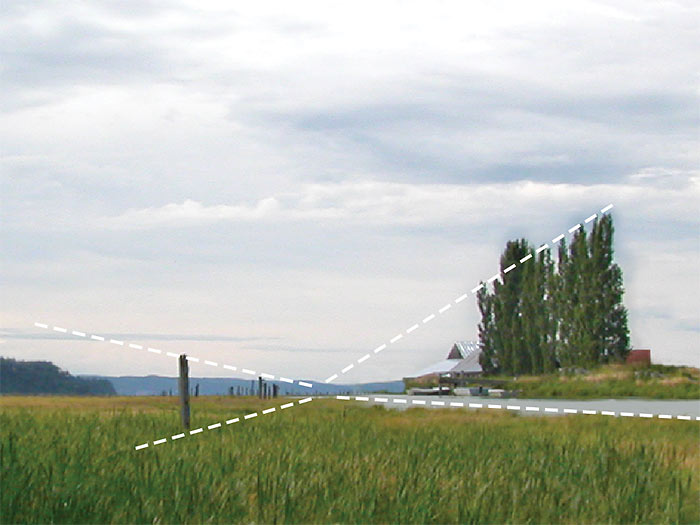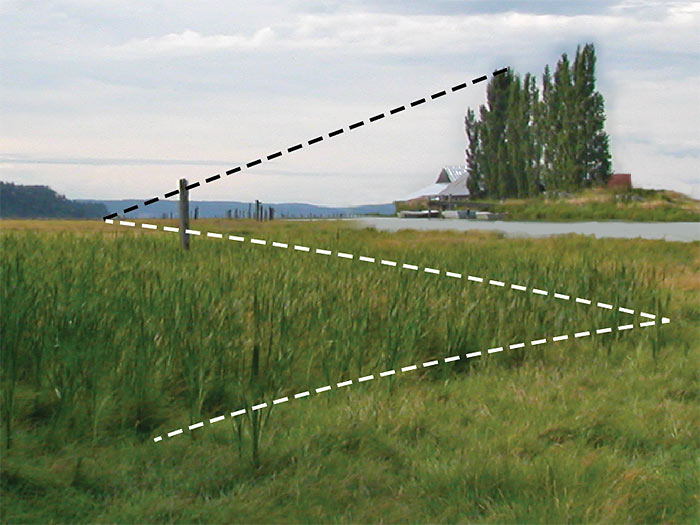Landscape composition is challenging. Nature presents all of itself, from east to west, completely unedited. More often than not, we have to don our Warrior Composer gear and be ready to radically select. In this short demo, I intentionally chose a rather poor photo to show that, with specific compositional choices, I can make an otherwise boring and static composition into something that might be a starting point for a plein air painting.
Original source photo
 The original scene captures the expansiveness of the fields, but in its “uncropped” state it is overly horizontal. The horizon line is also in the middle, which gives equal weight to the land and the sky. This makes the composition unfocused. What’s the picture about?
The original scene captures the expansiveness of the fields, but in its “uncropped” state it is overly horizontal. The horizon line is also in the middle, which gives equal weight to the land and the sky. This makes the composition unfocused. What’s the picture about?
There are several good spatial cues I can try to accentuate:
- the vertical post in the middle
- the diagonal furrow in the foreground where the crops meet the grass
- the trees on the right
- the sliver of the Skagit River, just below the trees, which tapers in linear perspective toward the center
Every compositional choice I make will aim to bring greater movement and depth to the picture. I’ll impose a limited focus, choose a land- or sky-domiant composition, and slightly shift the position of an element.
OPTION 1 – Sky Dominant

The first act of composition for every landscape painter is to apply a limited focus. “To eliminate the unnecessary so the necessary may speak,” said Hans Hoffman. Here, a limited focus reduces the excessive horizontality of the scene that makes it appear so unfocused. In a sky-dominant composition the sky appears more expansive compared to the land, fostering the impression that the horizon is at a great distance. This choice alone begins to create a sense of depth. The visual cues that suggest depth — the tree, the posts, and the river — are too far apart. By sliding the trees over to the left, I bring them much closer to the vertical posts. (I’m not a strong proponent of redesigning landscape space, but easy moves like sliding a tree over or increasing its height are within my comfort zone.) Now the posts, the trees, and the river are close enough together to heighten the perspective forming at the center (indicated by the dotted lines). These diagonal movements interrupt the sheer horizontality that was so present in the original.
OPTION 2 – Land Dominant

Here, by lowering my view and raising the horizon line, I create a land-dominant composition. This offers a larger foreground, which has the potential to carry the viewer’s eye across a greater length of space — especially if there are spatial cues in the foreground that imply recession. The furrow in the foreground, where the crops meet the grass, forms a diagonal that carries our eye back in a zig-zag fashion.
Diagonals are perhaps the most effective means of implying movement and recession. This solution speaks to the power of foregrounds — when populated with the proper cues — to create strong entries into the space.
Both the sky- and land-dominant compositions are big improvements. Each adds an essential ingredient in landscape composition — variation. When the two primary masses within the composition have different visual weights, greater interest is created. Add to that, an emphasis on the perspective cues that suggest recession, and I have taken an unfocused, overly horizontal composition and given myself a potential starting point.
Additional Resources
Composition Before Color — Considerations in the First Phases of Plein Air Painting
Demonstration: Exploring Landscape Composition Through a Limited Focus
from Landscape Painting: Essential Concepts and Techniques for Plein Air and Studio Practice:
Limited Focus through Selection, pages 86-87
Placement of the horizon line, pages 92-93
The foreground challenge, 96

5 Comments
Why keep the post in the composition?
First, the post serves as an opposing vertical in an otherwise all horizontal composition. Second, in combination with the smaller posts in the far distance, the posts form a pathway of implied perspective. You can see this indicated by the dotted lines in the sky-dominant example. I sometimes differentiate between actual perspective and implied perspective. In the sky-dominatn composition, for example, actual perspective is found along the river (albeit very shallow perspective), and implied perspective is formed when the eye “connects-the dots” between two or more points, as indicated by the pair of dotted lines on the left.
Mitch, thanks for the simple, accessible explanation. I’ve always said you’re a great teacher! Miss you — but we love being home in Oregon. Let me know if you’re ever down our way in Corvallis or the central coast.
I like the idea of diagonals in the composition to make the picture more interesting and do-able. I’ve been committed to using a photo as is, but can see that every photo has more potential when it’s looked at in this way. Maybe the original un-cropped photo can be used in an even better way! What a notion! I like it!
Thanks for the comment, Julie. You’ll find a huge, wonderful world of options opens up when your source photos are wide angle, when they include additional information. Consider that initial snapshot your bag of ingredients, not the final recipe. You get to choose the compositional ingredients, back in your “studio kitchen,” that will make the best pie!